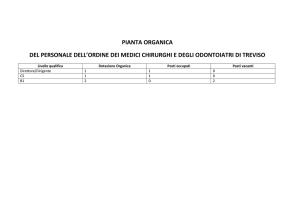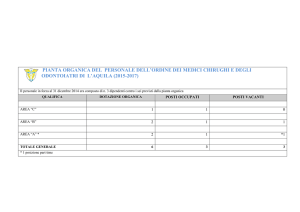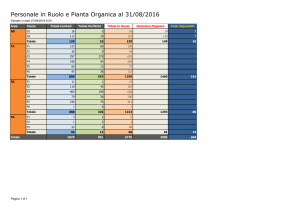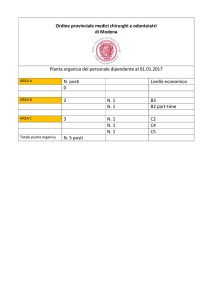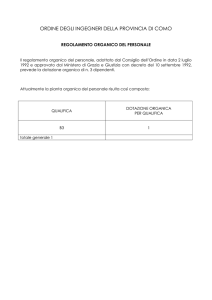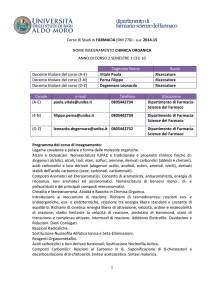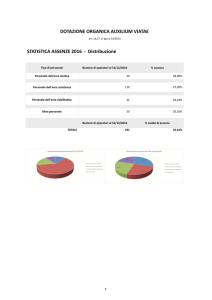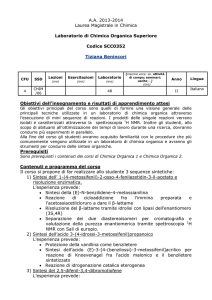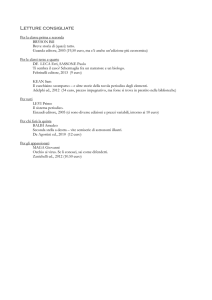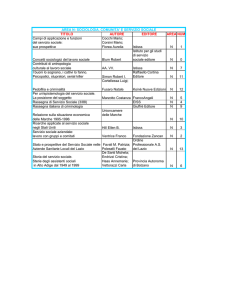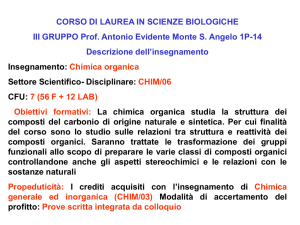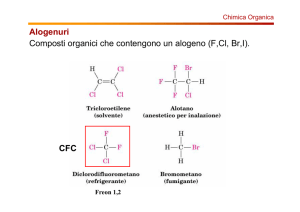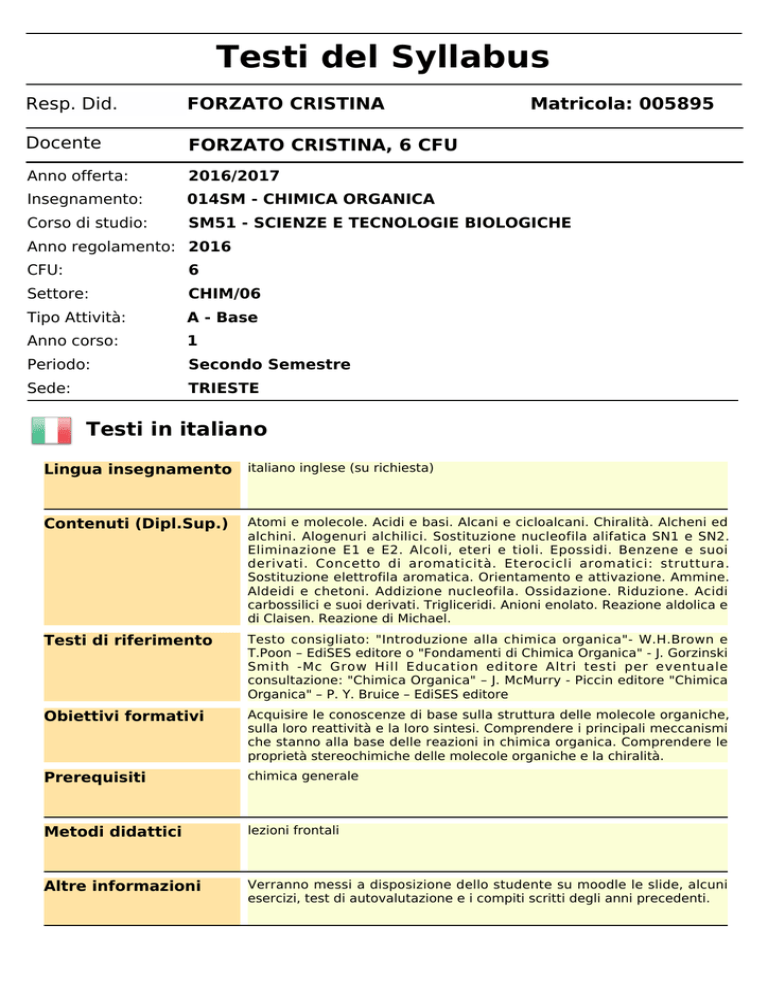
Testi del Syllabus
Resp. Did.
FORZATO CRISTINA
Matricola: 005895
Docente
FORZATO CRISTINA, 6 CFU
Anno offerta:
2016/2017
Insegnamento:
014SM - CHIMICA ORGANICA
Corso di studio:
SM51 - SCIENZE E TECNOLOGIE BIOLOGICHE
Anno regolamento: 2016
CFU:
6
Settore:
CHIM/06
Tipo Attività:
A - Base
Anno corso:
1
Periodo:
Secondo Semestre
Sede:
TRIESTE
Testi in italiano
Lingua insegnamento
italiano inglese (su richiesta)
Contenuti (Dipl.Sup.)
Atomi e molecole. Acidi e basi. Alcani e cicloalcani. Chiralità. Alcheni ed
alchini. Alogenuri alchilici. Sostituzione nucleofila alifatica SN1 e SN2.
Eliminazione E1 e E2. Alcoli, eteri e tioli. Epossidi. Benzene e suoi
derivati. Concetto di aromaticità. Eterocicli aromatici: struttura.
Sostituzione elettrofila aromatica. Orientamento e attivazione. Ammine.
Aldeidi e chetoni. Addizione nucleofila. Ossidazione. Riduzione. Acidi
carbossilici e suoi derivati. Trigliceridi. Anioni enolato. Reazione aldolica e
di Claisen. Reazione di Michael.
Testi di riferimento
Testo consigliato: "Introduzione alla chimica organica"- W.H.Brown e
T.Poon – EdiSES editore o "Fondamenti di Chimica Organica" - J. Gorzinski
Smith -Mc Grow Hill Education editore Altri testi per eventuale
consultazione: "Chimica Organica" – J. McMurry - Piccin editore "Chimica
Organica" – P. Y. Bruice – EdiSES editore
Obiettivi formativi
Acquisire le conoscenze di base sulla struttura delle molecole organiche,
sulla loro reattività e la loro sintesi. Comprendere i principali meccanismi
che stanno alla base delle reazioni in chimica organica. Comprendere le
proprietà stereochimiche delle molecole organiche e la chiralità.
Prerequisiti
chimica generale
Metodi didattici
lezioni frontali
Altre informazioni
Verranno messi a disposizione dello studente su moodle le slide, alcuni
esercizi, test di autovalutazione e i compiti scritti degli anni precedenti.
Modalità di verifica
dell'apprendimento
L'esame consiste in una prova scritta il cui superamento (voto minimo
18/30) darà accesso all'esame orale. Nella prova scritta verranno dati
dieci esercizi di chimica organica simili a quelli proposti durante le lezioni.
La prova orale consisterà in domande aperte sui principali concetti
affrontati durante il corso. In particolare verranno ripresi i concetti che lo
studente ha dimostrato di non aver compreso durante lo svolgimento
degli esercizi della prova scritta.
Programma esteso
Atomi e molecole. Acidi e basi. Alcani e cicloalcani. Chiralità. Alcheni ed
alchini. Alogenuri alchilici. Sostituzione nucleofila alifatica SN1 e SN2.
Eliminazione E1 e E2. Alcoli, eteri e tioli. Epossidi. Benzene e suoi
derivati. Concetto di aromaticità. Eterocicli aromatici: struttura.
Sostituzione elettrofila aromatica. Orientamento e attivazione. Ammine.
Aldeidi e chetoni. Addizione nucleofila. Ossidazione. Riduzione. Acidi
carbossilici e suoi derivati. Trigliceridi. Anioni enolato. Reazione aldolica e
di Claisen. Reazione di Michael.
Testi in inglese
Lingua insegnamento
Italian English (upon request)
Contenuti (Dipl.Sup.)
Atoms and molecules. Acids and bases. Alkanes and cycloalkanes.
Chirality. Alkenes and alkynes. -Alkyl halides. Nucleophilic aliphatic
substitution SN1 and SN2. Elimination reaction E1 and E2. Alcohols,
ethers and thiols. Epoxides. Benzene and its derivatives. Concept of
aromaticity. Heterocyclic aromatic compounds. Electrophilic aromatic
substitution. Effect of the subsituents. Amines. Aldehydes and ketones.
Nucleophilic addition. Oxidation. Reduction. Carboxylic acids and their
derivatives. Triglicerides. Enolate anions. Aldol reaction. Claisen reaction.
Michael reaction.
Testi di riferimento
Recommended text: "Introduzione alla chimica organica"- W.H.Brown e
T.Poon – EdiSES editore or "Fondamenti di Chimica Organica" - J.
Gorzinski Smith -Mc Grow Hill Education editore Other books for
consultation: "Chimica Organica" – J. McMurry - Piccin editore "Chimica
Organica" – P. Y. Bruice – EdiSES editore
Obiettivi formativi
To know the structure, the reactivity and the synthesis of the most
important compounds in organic chemistry. To understand the most
important mechanisms of the organic chemistry reactions. To understand
the importance of the sterochemistry and chirality in organic chemistry.
Prerequisiti
General chemistry
Metodi didattici
lectures
Altre informazioni
The students will find on moodle all the material required to prepare the
exam such as slides of lectures, exercises and previous written tests.
Modalità di verifica
dell'apprendimento
The exam will be a written test with ten exercises similar to those
proposed during the course. A positive evaluation of the written test (at
least 18/30) will give access to the oral examination in which there will be
questions on the principal matters explained during the course with
particular attention to those apllied in the exercises of the written test
and that were not solved correctly.
Programma esteso
Atoms and molecules. Acids and bases. Alkanes and cycloalkanes.
Chirality. Alkenes and alkynes. Alkyl halides. Nucleophilic aliphatic
substitution SN1 and SN2. Elimination reaction E1 and E2. Alcohols,
ethers and thiols. Epoxides. Benzene and its derivatives. Concept of
aromaticity. Heterocyclic aromatic compounds. Electrophilic aromatic
substitution. Effect of the subsituents. Amines. Aldehydes and ketones.
Nucleophilic addition. Oxidation. Reduction. Carboxylic acids and their
derivatives. Triglicerides. Enolate anions. Aldol reaction. Claisen reaction.
Michael reaction.

